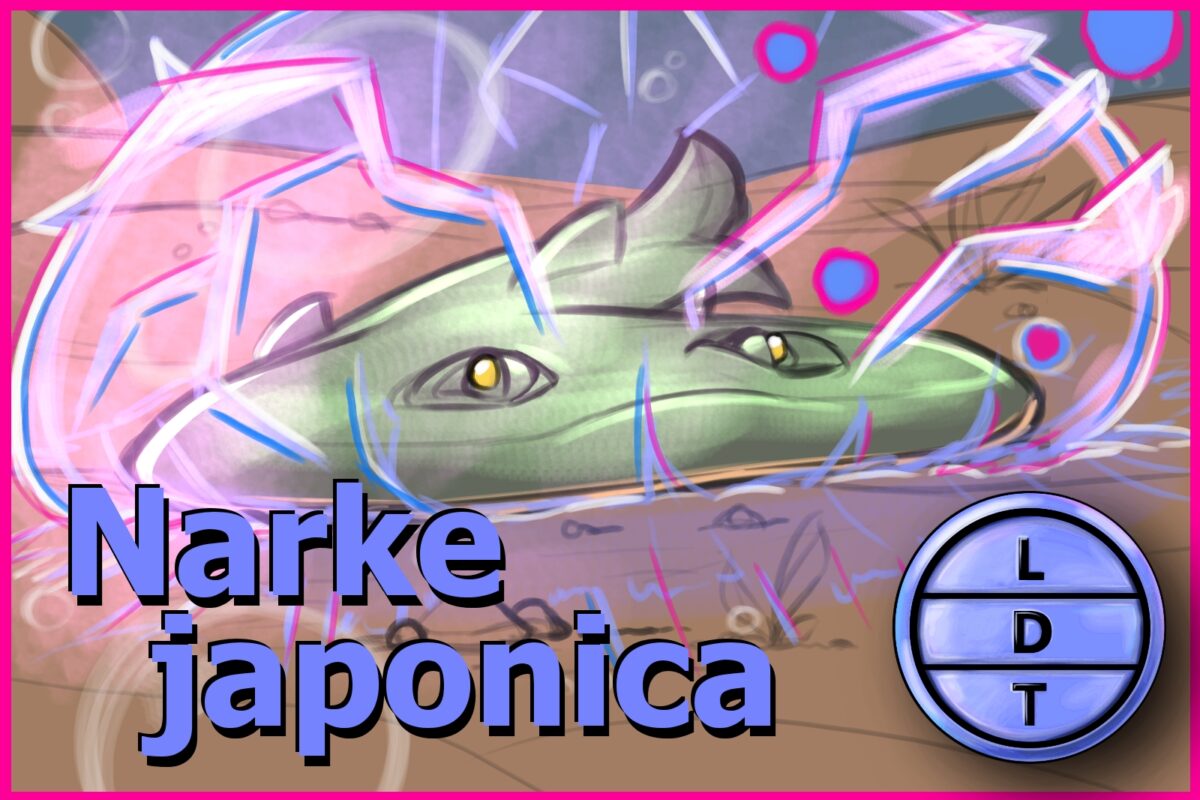“…and today we’re talking about a spicy dish. But more on that later.”
Deep in the water where the fish hang out, lives a small sleepy saucer we know not too much about
He’s a zap zap fish with a zap zap belly
And his neat electric organs turn your insides into jelly
He hides beneath the sand and waits for food to flutter by
So he can snatch it up and wait for another passerby
Cause he’s a zap zap fish with a zap zap belly
And it’s just how he survives in Life Death and Taxonomy
Description
- They are round, disk-shaped rays with flat bodies.
- They have a similar top down shape as a horseshoe crab, but they also have a longer fishy tale.
- They have soft skin and lack firm fish scales which the wiki writer went above and beyond by calling “dermal denticles.”
- They have a spotted, mottled look with a light brown tannish base and dark brown spots. But some are a monochromatic tan color.
Measure Up
Welcome to the beloved Measure Up segment. The official listener’s favorite part of the show! The part of the show when we present the animal’s size and dimension in relatable terms through a quiz that’s fun for the whole family. It’s also the part of the show that’s introduced by you when you send in audio of yourself saying, singing, or chittering the words Measure Up into ldtaxonomy at gmail dot com. We don’t have a new Measure Up intro!
- Cassowary
- Koala
- Kangaroo
- Tortoise
Length
- 40 cm (16 in)
- How many Japanese Sleeper Rays go into the height of Eternatus, the poison dragon pokemon that was introduced in Pokemon Sun and Moon?
- Hint: Eternatus the tallest pokemon when it goes into its special Eternamax Eternatus phase that more than doubles its size. Even without that, it’s the tallest pokemon.
- 50 rays. Eternatus is 65’07” or 20.0 m.
Depth
- 12–23 m (39–75 ft)
- How many Japanese Sleeper Rays go into the height of the most recent iteration of Godzilla?
- Hint: As the King of Monsters in the 2019 Godzilla movie and in his face off with King Kong, he is the tallest he’s ever been. A far cry from his original 164 feet (50 meters) in 1954.
- 5.2 dive depths. Godzilla is 394 feet (120 meters).
Fast Facts
Japanese sleeper rays are so called for their lackadaisical approach to life. They spend most of their time on the sea floor buried beneath the sediment.
They live in the northwestern pacific ocean on th continental shelf near Japan, Korea, China, and Taiwan. They’re found near and far away from shore, but they prefer sandy areas near coral reefs. They essentially like oceanic suburbia.
These rays are viviparous like many of their shark kin. They develop on a diet of yolk and then histroph, which is milk from the uterus.
They are born into litters of five or less. And they all celebrate their b’nei mitzvah when they’re around 23 to 37 cm long.
If you want one as a pet, you’re out of luck because they don’t adapt well to captivity. Still, they may be bycatch in shrimp fishing. They have no commercial use and they would be thrown back but they usually don’t survive being caught. This may have contributed to their decline, since the fishing trade in East Asian waters is extensive.
Major Fact: Electric Tough Love
Like most fish, the Japanese sleeper ray has a litany of predators to keep an eye out for like the blotchy swell shark.
Fish use all kinds of tactics to both catch food and avoid being caught as food. Some use camouflage, some use speed, some just hide, others use venom or poison. But this ray uses a sturdy pair of duracels.
Like the electric eel that we covered, weaponized electricity in animals comes from specialized electric organs. But in the sleeper ray, these organs are made of electrocytes, cells filled with a jelly substance that are stacked in vertical columns. Since each organ is made up of these columns, they function as a series of batteries with their poles aligned in parallel.
This allows them to deliver an electric shock of up to 80 volts. Remember that voltage is the speed of the electrons in electricity while amps are the volume, or number of electrons. So just knowing the volts doesn’t tell us all that much. If something produces 10K volts but 0.0001 amps, it’s not producing much.
However, I could not find a single place that went into detail about the current these guys can produce. But I did find one source that said that Atlantic Torpedo Rays, another species of electric ray, can produce up to 30 amps with 50-200 volts.
To put it into perspective, a dishwasher uses about 10 amps while a lightning strike is over 20K. This isn’t necessarily lethal to humans, but it can be very painful and could kill someone with a heart issue, though no cases have been reported.
The main use for this electric attack is for defense against the dark arts but some sparse observations could point to using it for catching prey. Fishermen often catch these guys in their nets, but the rays usually discharge their electricity as soon as they are disturbed and it takes time for the batteries to charge again.
They’ve been fished for commercial purposes in the past since their oil was apparently as useful as whale oil for lamps and was even used for old timey medicinal purposes.
Ending: So sleep well, pick your battles, and shock the haters with your natural energy like the Japanese sleeper ray here in Life, Death, and Taxonomy.

